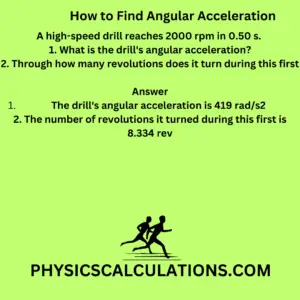Question
A high-speed drill reaches 2000 rpm in 0.50 s.
1. What is the drill’s angular acceleration?
2. Through how many revolutions does it turn during this first
Answer
- The drill’s angular acceleration is 419 rad/s2
- The number of revolutions it turned during this first is 8.334 rev

Explanation
Solution to 1
- We will start by solving question one (1) from the question
Data: The information from the question
We have angular velocity, v = 2000 rpm [Note: rpm = revolution per minute]
1 revolution = 3600 per rotation = 2 x 1800 per rotation = (2 x π) / 1 rotation = 2π
Additionally, 1 minute = 60 seconds = 60 s
We can now confidently say that the angular velocity which is 2000 rpm can be rewritten as:
angular velocity, ω = 2000 x (2π / 60) = (2000 x 2 x 3.142) / 60 = 209.5 rad/s
The time given to us from the question is t = 0.5 seconds
Note: Don’t forget that the formula for angular velocity is θ(t) = θ(0) + ω(0)t + 0.5 at2 or ω = 2πN/60
where ω is the angular velocity, and N is the number of revolutions per minute.
Unknown: Information we need to find
Angular acceleration, a = ?
Formula: The equation that will help us solve the problem
Remember that a = v / t
Therefore, we will use the formula a = ω / t
Solution
We will substitute our data into the formula
a = ω / t = 209.5 / 0.5 = 419 rad/s2
Therefore, the drill’s angular acceleration is 419 rad/s2.
Solution to 2
2. Moving on to the second question, we will use the formula below to find the number of revolutions:
θ(t) = θ(0) + ω(0)t + 0.5 at2
Where θ(t) = ?, θ(0) = 0, ω(0)t = 0, a = 419 rad/s2, and t = 0.5 s
Therefore, after substituting the above data into the formula, we will have:
θ(t) = θ(0) + ω(0)t + 0.5 at2 = 0 + 0 + 0.5 x 419 x 0.52 = 52.375 rad/s
By converting the above answer from rad/s to revolution, we will obtain:
θ(t) = 52.375 rad/s x (1rad/2π) = 52.375 rad/s x 0.159134 = 8.334 rev [1 rad = 0.159134 rev]
Therefore, the number of revolutions is 8.334 rev.
You may also like to read:
The motorcycle is traveling at a constant speed of 76km/h.
Reference:
